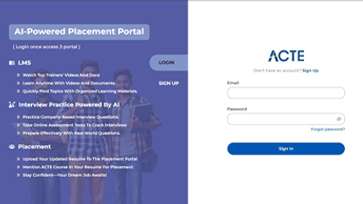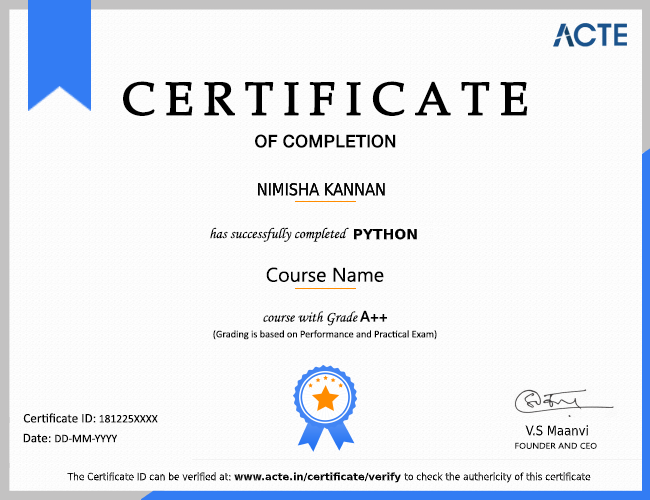ACTE course includes basic to advanced level and our html course is designed to get the placement in good MNC companies as quickly as once you complete the training course. Our trainers are HTML5 CSS certified experts and experienced working professionals with hands on real time multiple projects knowledge. We have designed our course content and syllabus based on students requirement to achieve everyone's career goal.
- According to Payscale.com, HTML & CSS is the most in-demand IT skill in the current market.
- As its adoption is rapidly increasing, the demand for skilled professionals is growing significantly.
- The demand for trained HTML & CSS professionals will increase even further due to its growing popularity across multiple organizations around the globe.
HTML & CSS is the main powerhouse behind the rapidly evolving Internet. It is the present and will be the future. The rampant development of the high-level programming language asserts to the fact of HTML & CSS is the future.
As per the industry stats, most hiring is happening for the below roles:
- Software developers
- Entrepreneurs who want to build their applications using Full stack
- Technical project leads and managers
- Graduates who wish to learn Full stack
- Back-end developer
- Front-end developer
- Mobile app developer
- UX/UI designer
- Machine learning engineer
- Aspiring web developers
YES,Most of the companies call for front end developers than HTML and css developers.And importantly, Most of the companies who call for HTML and css experts will ask your knowledge in design tools like Photoshop and illustrator etc..
We are happy and proud to say that we have strong relationship with over 700+ small, mid-sized and MNCs. Many of these companies have openings for HTML & CSS .Moreover, we have a very active placement cell that provides 100% placement assistance to our students. The cell also contributes by training students in mock interviews and discussions even after the course completion.
- Follow the structure and markup of HTML5, and explore new features in this version
- Design websites using HTML5
- Understand the various components of CSS3, and how to style web pages
- Design page layouts and employ positioning with CSS3
- Use best practices in these two technologies
- Build fully functional and creatively designed websites
There are no specific prerequisites to learn Languages.You only need to have basic computer knowledge along with a passion for web development, to pursue this course.
Yes,It doesn't require prior programming experience.
Our courseware is designed to give a hands-on approach to the students in HTML & CSS . The course is made up of theoretical classes that teach the basics of each module followed by high-intensity practical sessions reflecting the current challenges and needs of the industry that will demand the student's time and commitment.
Yes,HTML5 and CSS3 together bring enhanced functionalities in web page development like multi-media support to add audio/Video files, canvas, real-time communication, local storage, and robust design. Embracing this technology will surely benefit you and your organisation.
Some benefits are as follows:
- The World Wide Web is growing every day guaranteeing you plenty of opportunities as an employee or as a freelance web developer.
- HTML 5.2 is recommended by the World Wide Web Consortium for web pages and many leading companies are implementing or upgrading to it.
- As per ZipRecruiter, the average salary of a person proficient in HTML5 and CSS3 is $87,870
- You can work on your own business website and save money in the bargain
HTML & CSS is a vital area of many IT job roles and gaining the applicable expertise and passing HTML & CSS exams in this area will greatly enhance your employability.
Its better to select ACTE which comprises these below factors.
- Appropriate training with well Equipped facilities.
- Technical HTML & CSS certifications
- Complete knowledge in the HTML & CSS.
- Technical theory
- Mock Interviews
HTML & CSS allows you to build interactive websites.HTML & CSS has become an essential web technology along with HTML and CSS, as most browsers implement HTML & CSS . Thus, You must learn HTML & CSS if you want to get into web development, and you must learn it well if you're planning on being a front-end developer or on using HTML & CSS for backend development.Furthermore, HTML & CSS usage has now extended to mobile app development, desktop app development, and game development. All in all, it has exploded in popularity and is now a very useful skill to learn.
Here are a few reasons for you to pursue a career in HTML & CSS :
- Hands-on engagement with the best-Engineering platform in human history.
- A sense of mission and higher purpose
- The emergence of agile HTML & CSS Developers(Web Development)
- Enterprise applications are multiplatform/Web designing/Web development
- community support and training.
- Build a lucrative career.
How Does HTML Work?
- HTML documents are files that end with a .htmlor .htm You can view then using any web browser (such as Google Chrome, Safari, or Mozilla Firefox). The browser reads the HTML file and renders its content so that internet users can view it.
- Usually, the average website includes several different HTML pages. For instance: home pages, about pages, contact pages would all have separate HTML documents.
- Each HTML page consists of a set of tags(also called elements), which you can refer to as the building blocks of web pages. They create a hierarchy that structures the content into sections, paragraphs, headings, and other content blocks.
Overviewing The Most Used HTML Tags
HTML tags have two main types: block-level and inline tags.
- Block-level elements take up the full available space and always start a new line in the document. Headings and paragraphs are a great example of block tags.
- Inline elements only take up as much space as they need and don’t start a new line on the page. They usually serve to format the inner contents of block-level elements. Links and emphasized strings are good examples of inline tags.
HTML Evolution. What Differs Between HTML and HTML5?
Since the first days, HTML has gone through an incredible evolution. W3C constantly publish new versions and updates, while historical milestones get dedicated names as well.
HTML4 (these days commonly referred to as “HTML”) was published in 1999, while the latest major version came out in 2014. Named HTML5, the update has introduced many new features to the language.
One of the most anticipated features of HTML5 is native support for audio and video embedding. Instead of using Flash player, we can simply embed videos and audio files to our web pages using the new <audio></audio> and <video></video> tags. It also includes in-built support for scalable vector graphics (SVG) and MathML for mathematical and scientific formulas.
HTML5 introduced a few semantic improvements as well. The new semantic tags inform browsers about the meaning of content, which benefits both readers and search engines.
The most popular semantic tags are
- <article></article>
- <section></section>
- <aside></aside>
- <header></header>
- <footer></footer>
Pros of HTML
- A widely used language with a lot of resources and a huge community behind.
- Runs natively in every web browser.
- Comes with a flat learning curve.
- Open-source and completely free.
- Clean and consistent markup.
- The official web standards are maintained by the World Wide Web Consortium (W3C).
- Easily integrable with backend languages such as PHP and Node.js.
How are HTML, CSS, and JavaScript related?
While HTML is a powerful language, it isn’t enough to build a professional and fully responsive website. We can only use it to add text elements and create the structure of the content.
However, HTML works extremely well with two other frontend languages: CSS (Cascading Style Sheets), and JavaScript. Together, they can achieve rich user experience and implement advanced functions.
- CSS is responsible for stylings such as background, colors, layouts, spacing, and animations.
- JavaScript lets you add dynamic functionality such as sliders, pop-ups, and photo galleries.
Think of HTML as a naked person, CSS as the clothing, and JavaScript as movements and manner.
HTML is the main markup language of the web. It runs natively in every browser and is maintained by the World Wide Web Consortium.
You can use it to create the content structure of websites and web applications. It’s the lowest level of frontend technologies, that serves as the basis for styling you can add with CSS and functionality you can implement using JavaScript.































